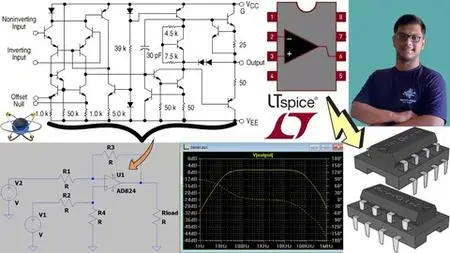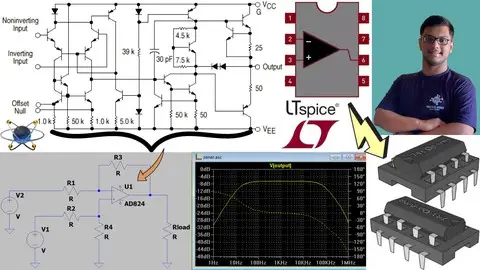Integrated Circuits: Learn Operational Amplifiers On Ltspice
Published 11/2023
MP4 | Video: h264, 1920x1080 | Audio: AAC, 44.1 KHz
Language: English | Size: 1.31 GB | Duration: 3h 34m
Published 11/2023
MP4 | Video: h264, 1920x1080 | Audio: AAC, 44.1 KHz
Language: English | Size: 1.31 GB | Duration: 3h 34m
Semiconductor Devices: Hands on Lab Based Course on Op-Amp using Ltspice Analog Electronics & Hardware Design - 7
What you'll learn
OpAmp Circuit Design
LTspice Circuit Simulation Tutorial
Operating Op-Amp as an Inverting Amplifier
Operating Op-Amp as a Non-Inverting Amplifier
Operating Op-Amp as a Buffer Amplifier
Operating Op-Amp as an Adder
Operating Op-Amp as a Subtractor
Operating Op-Amp as a Differentiator
Operating Op-Amp as a Integrator
Operating Op-Amp as a Comparator
Operating Op-Amp as a Logarithemic Amplifier
Operating Op-Amp as a Anti-Logarithemic Amplifier
Building a Schmitt Trigger using an Operational Amplifier
Numericals
Projects based on Operational Amplifiers
Requirements
A moderate understanding of English even though the author tries to explain everything as simply as possible.
A computer in order to simulate the circuits that we are going to build together.
A basic understanding of mathematics.
Students should have strong command on Analog Electronics (BJTS, FETs, Diodes) orelse you can look forward to enroll in previous courses
Description
Discover the fascinating world of Integrated Circuits and Operational Amplifiers in our user-friendly LTSpice course. This course is designed to help you become a pro in using these crucial electronic parts. You'll gain the knowledge and skills needed to create complex circuit designs and analyze them with accuracy.In this enriching journey, you'll embark on a comprehensive exploration of the theoretical foundations and practical applications of operational amplifiers. Guided by expert instructors, you'll unravel the complexities of these fundamental elements, gaining insights that go beyond textbooks and conventional learning.By delving into real-world scenarios and hands-on exercises, you'll develop an intuitive grasp of how operational amplifiers function in various circuit configurations. Our in-depth tutorials will empower you to harness the full potential of LTSpice, enabling you to simulate, optimize, and troubleshoot intricate circuits effortlessly.@ Course Roadmap:Basic Concepts of an Operational Amplifier: Start with the essentials. Gain a solid foundation in the theory and working principles of operational amplifiers.LTSpice Circuit Simulation Tutorial: Master LTSpice, a powerful circuit simulation tool. Learn how to create, simulate, and analyze circuits effectively.Operating Op-Amp as an Inverting Amplifier: Dive into practical applications. Explore how operational amplifiers can be used as inverting amplifiers.Operating Op-Amp as a Non-Inverting Amplifier: Continue your journey by studying non-inverting amplifier configurations and their real-world applications.Operating Op-Amp as an Adder: Understand how operational amplifiers can be employed to create adder circuits, a crucial skill in electronic design.Operating Op-Amp as a Subtractor: Discover the art of subtraction using operational amplifiers. Learn the intricacies of designing subtractor circuits.Operating Op-Amp as a Differentiator: Delve into signal processing. Learn how operational amplifiers can be used as differentiators.Operating Op-Amp as an Integrator: Explore the concept of integration. Understand how operational amplifiers can perform integration tasks.Operating Op-Amp as a Comparator: Uncover the versatility of operational amplifiers as comparators. Learn to build circuits for comparison tasks.Operating Op-Amp as a Logarithmic Amplifier: Study logarithmic amplifiers and their applications in electronic systems.Operating Op-Amp as an Anti-Logarithmic Amplifier: Explore the complementary anti-logarithmic amplifiers and their utility.Building a Schmitt Trigger using an Operational Amplifier: Learn how to construct a Schmitt trigger, a crucial component in digital circuits.Numericals: Apply your theoretical knowledge to practical problem-solving. Solve numerical exercises to reinforce your learning.Projects Based on Operational Amplifiers: Take your skills to the next level by working on exciting projects that incorporate operational amplifiers.Join us on this educational journey into the world of operational amplifiers and LTSpice, and equip yourself with the skills and knowledge to design, simulate, and analyze electronic circuits effectively. Whether you're a beginner or an enthusiast, this course is your gateway to mastering these critical components of modern electronics. Enroll today and embark on your path to expertise in integrated circuits and operational amplifiers.
Overview
Section 1: Introduction
Lecture 1 Introduction
Lecture 2 Decoding Operational Amplifiers
Section 2: Understand the Basic Parameters of an Amplifiers
Lecture 3 Parameters involved in an Amplifier
Lecture 4 What should be the input impedance of an amplifier?
Lecture 5 What should be the output impedance of an amplifier?
Lecture 6 What should be the Gain and Bandwidth of an amplifier?
Section 3: Basic Concepts of an Op-Amp
Lecture 7 Symbolic Representation of an Op-Amp
Lecture 8 Pin Diagram of Op-Amp (IC741)
Lecture 9 Block Diagram of an Op-Amp
Lecture 10 Why Differential Amplifier is used at the Input Stage of Operational Amplifier
Lecture 11 Concept of Virtual Short
Lecture 12 Transfer Characteristics of an Op-Amp
Lecture 13 Single and Dual Supply Mode in Op-Amp
Section 4: Introduction to LTSpice Software
Lecture 14 Find Voltage, Current & Power in Voltage Divider Circuit Using LTSpice Software
Lecture 15 AC Analysis:- Analyzing Low Pass Filter on LTSpice Software
Electrical Engineers,Electronic Engineers,Biomedical Engineers,Instrumentation Engineers,Anyone who wants to learn LTspice Software,Anyone who wants to learn Op-Amp Based Circuits



